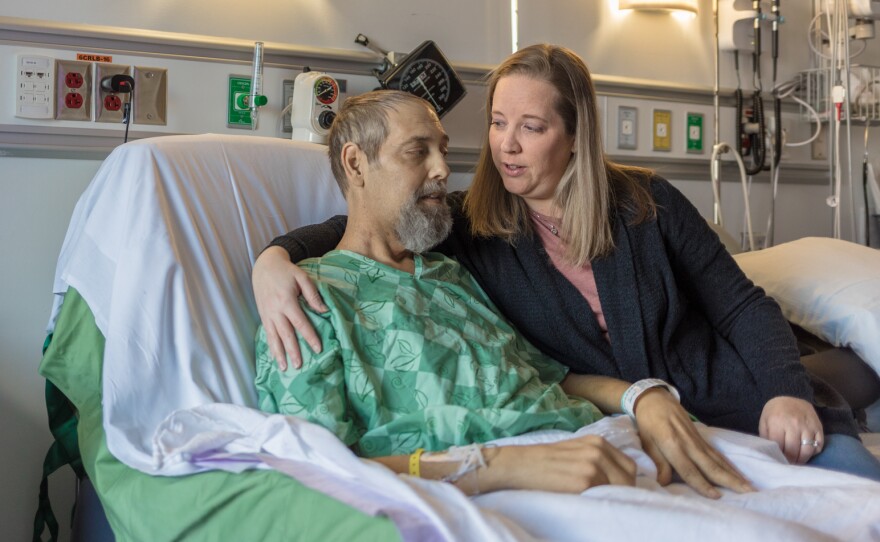Dr. Jonathan Sevransky was intrigued when he heard that a well-known physician in Virginia had reported remarkable results from a simple treatment for sepsis. Could the leading cause of death in hospitals really be treated with intravenous vitamin C, the vitamin thiamine and doses of steroids?
"Hundreds of thousands of people die in the U.S. every year and millions of people in the world die of this," says Sevransky, a critical-care physician at Emory University. "So when somebody comes out with a potential treatment that is cheap and relatively easily available, it's something you want to think about."
Sevransky ended up doing much more than think about it. The Marcus Foundation in Atlanta, a major donor to Emory, approached critical care doctors there after hearing about the potentially revolutionary treatment and offered to fund a careful scientific study to see whether it actually worked.
"One of the things they were very interested in doing was getting an answer quickly," Sevransky says. So he teamed up with researchers at Johns Hopkins University in Baltimore and Vanderbilt University in Nashville, Tenn., to design a study that could take place at up to about 40 hospitals simultaneously, in order to get a large number of patients into the trial in short order.
Dorian Pelfrey was one of the first to enroll in the study. He and his wife, Shauna, had traveled to Emory from their home in Greenville, S.C., because the 44-year-old man's liver was failing. He was in urgent need of a transplant.
Dorian had exceptionally good news — within days of getting on the transplant list, a liver became available for him. But he also had a serious setback. Shortly after arriving at Emory he developed sepsis – the body's out-of-control reaction to an infection.
Dorian's blood pressure dropped, and his heartbeat became irregular. "He went from doing OK to just doing really bad, in very little time," Shauna says. And she was doubly concerned, "especially with trying to keep him well enough to get to a liver transplant."
One of his doctors asked Shauna whether Dorian would consider enrolling in the clinical trial. He would have a 50-50 chance of getting the vitamin mixture or standard fluids for hydration through an IV. Doses of corticosteroids, the kind produced by the adrenal gland, are also part of the experiment. (Since Dorian's doctor had already prescribed those for him, he would keep taking the medicine instead of taking the material in the study that might or might not be the steroid.)
Everyone in the trial would get the usual intensive medical care from nurses and medical staff to treat sepsis. That includes high-dose antibiotics, careful control of blood pressure to prevent or reverse shock and, often, mechanical help in breathing. Shauna decided to enroll him, and within hours, doctors and nurses swung into action and started giving him the experimental drip.
"It was a long four days of lots of medicine, lots of care, from a lot of different doctors, a lot of different areas of medicine," Shauna recalled a few weeks later. "And then he did become well enough to receive a liver transplant."
The Pelfreys have no idea whether he got the experimental treatment or the placebo. But Shauna says she's OK with that uncertainty. "I'm all for research to see if it could help another family — somebody else's loved one," she says.
In any event, Dorian's health has slowly been improving since his bout with sepsis and his liver transplant.
He is one of at least 200 people — perhaps as many as 500 — who will participate in this clinical trial, which is named VICTAS (VItamin C, Thiamine And Steroids in Sepsis). The experience of those volunteers could help provide a quick answer about whether this treatment is a medical breakthrough or a flop.
Clinical trials like this are the primary way that medical scientists sort out what just seems to work from what actually does. There are currently more than 100,000 listed in a federal database as ongoing in the United States, though many will never be completed for a multitude of reasons.
Studies in critical care medicine are particularly challenging. Doctors have to move fast to respond to rapidly changing health conditions, and patients are often not in a position to give informed consent. They may be delirious or even in a coma. Gradually, though, study designers have figured out how to get these studies done. And that's changing the practice of critical care medicine for the better.
"Back in the dark ages when I was in training, almost 100 percent of what we did was based on experience" rather than scientific evidence, Sevransky says. And he remembers that the specialists at one hospital would sharply disagree with those at another.
"Now probably 25 percent of what we do is based on data and 75 percent is based on experience," he says. "And it would be awfully nice to raise that 25 percent much higher."
That's part of his motivation for doing the study, which, after all, will contribute to scientific knowledge whether the treatment is a great success, a dud or something in between. Sevransky finds that gratifying.
"And it's enjoyable to work with a team of people," he adds. "Research, it's like a team sport." It's also a huge time commitment — Sevransky figures he and his collaborators put in something like 10,000 hours to bring the study to life.
The team in this case includes those who design the study to make sure it provides scientifically rigorous results. Scientists at Johns Hopkins were responsible for making sure the study passed ethical muster. Collaborators at Vanderbilt will process and analyze the data.
Each hospital has a team to coordinate the experimental treatment. All this work takes time and money, typically several million dollars for a study of this nature, though Emory isn't disclosing the budget for it.
At Emory, Dr. Kate Nugent and clinical research nurse Christine Spainhour did the all-important legwork of telling doctors in the various intensive care units and emergency rooms that the trial existed – and how to identify patients who could be eligible.
Nugent, who oversees the trial at Emory, ginned up enthusiasm for the study, and now, she and Spainhour take calls on the trial's dedicated hotline any time of the day or night when a doctor has identified a potential participant.
Time is of the essence. Her goal is to review the patient's chart within 30 minutes and to start treatment within about four hours. Getting the word out to the various ICUs was the big push. "After patients started enrolling, it was like a ball rolling down a hill and people are very excited about it," Nugent says.
To date, the trial has enrolled more than 70 patients.
And the clock is ticking.
"Getting a clinical trial done within one year, which is our goal, is actually lightning fast," says Dr. Craig Coopersmith, who currently oversees critical care at Emory. Indeed, speed is baked into the study design.
Once 200 patients have been enrolled, an independent group of researchers will take a peek at the data to see whether there's a big difference between the patients who got the vitamins and those who got the placebo.
"If there's a huge effect, the trial gets stopped prior to the 500 patients," Coopersmith says.
A huge effect would be like what Dr. Paul Marik has reported from his hospital in Norfolk, Va. He asserts that few people in his critical care unit die from sepsis. (He was inspired by related research on vitamin C by Dr. Alpha Fowler at Virginia Commonwealth University).
Coopersmith expects that, if there is an effect outside Marik's hospital, it will be smaller. So the study involving 500 patients is designed to detect whether the vitamin infusions improve outcomes by at least 10 percent.
That may not sound like a lot, but "10 percent would be massively important," Coopersmith says. "Mortality from sepsis is higher than any other condition in the hospital," so a 10 percent decrease would save tens of thousands of lives in the U.S. every year.
This is such an important question, there are actually about a dozen studies of vitamin treatment for sepsis are underway around the world. Researchers at Beth Israel Deaconess Medical Center, a Harvard-affiliated hospital, is in the midst of a study that plans to enroll 200 patients. As of Dec. 11, they had enrolled 87 people in 12 hospitals. (This study is also funded by a private foundation, The Open Philanthropy Project).
Together, these studies will either tell doctors that there's a remarkable new treatment for a deadly disease or that it was another good idea that just didn't pan out.
You can reach NPR science correspondent Richard Harris at rharris@npr.org.
Copyright 2018 NPR. To see more, visit https://www.npr.org.






